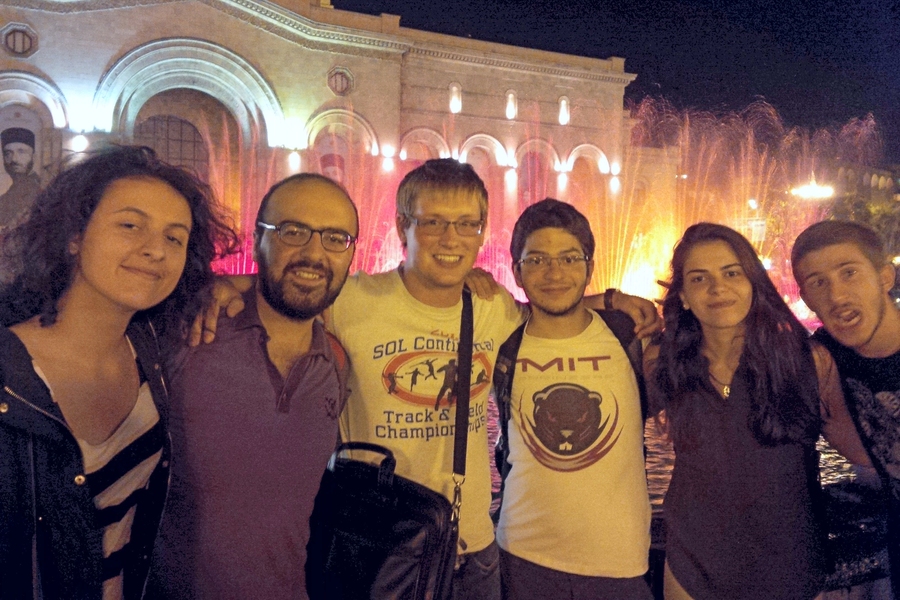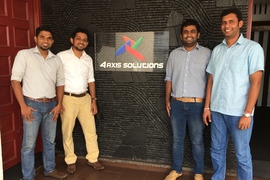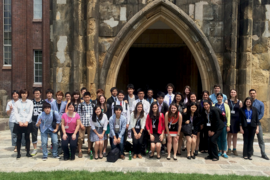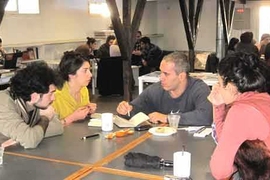“Nothing opens your eyes to the challenges and needs of other people more than working in a foreign country,” says Narek Dshkhunyan, a MISTI Global Teaching Labs (GTL) alumnus and MIT senior in computer science and molecular biology. Dshkhunyan sees himself as a world citizen and partly credits MIT International Science and Technology Initiatives (MISTI) for this. He explains, “MISTI definitely made me more knowledgeable about the cultures of other countries. It showed me that all societies in the world, regardless of their structure and cultural differences, face very similar challenges, and how much science and education can help them overcome those problems.” This past summer Dshkhunyan returned to Armenia, his native country, with four MIT peers to teach high school students as part of the GTL program.
Launched in 2009, MISTI GTL has placed over 300 MIT students with teaching positions at high schools in 10 countries around the world. Typically run over MIT’s Independent Activities Period (IAP) in January, GTL guides MIT students in preparing tailored courses in science, technology, engineering, and math (STEM) and entrepreneurship that are meant to complement the host schools’ curriculum and introduce MIT’s hands-on approach to education. This past summer marked GTL’s first summer program and MISTI’s first activity in Armenia.
The Armenia pilot was launched in response to enthusiasm from GTL alumni. “Armenian MIT students who participated in GTL Italy loved the program and wished to offer the same experience to high school students in their own country,” explains Serenella Sferza, creator of the GTL program and co-director of the MIT-Italy Program. GTL Armenia became a reality largely due to the Luys Foundation, an educational institute that supports Armenian students who are studying at the world’s top colleges, including MIT. In exchange for this support, Luys Fellows commit to share their knowledge through a variety of summer projects in Armenia. The Luys Foundation offered to provide logistical support and include the GTL pilot among these summer projects. MISTI GTL accepted enthusiastically. “We were impressed by Luys’ strong commitment to education and by our MIT Armenian students,” Sferza says.
The GTL team, composed of five MIT students, was placed at the Ayb School, a private educational complex in Yerevan for a five-week stay. Courses offered included computational neuroscience, machine learning, electricity and magnetism, debate, and toy product design. “I taught physics for two hours every morning,” explains Daniel Corney, an MIT junior in nuclear science and engineering, who was blown away by his students’ progress. Each MIT instructor taught his/her own classes and were responsible for grading classwork and homework. “The students were very inspiring,” Corney shares. “It was exciting to see students so motivated, and I firmly believe most of them think their education will allow them the ability to fundamentally change the world.” Many Ayb School graduates are admitted to top colleges worldwide and become Luys scholars. As the GTL pilot was taking place, another MIT team installed a fabrication lab ("Fab Lab") at the school.
Like all MISTI students, the GTL Armenia students underwent tailored preparation and training. Jacqueline Karaaslanian, executive director of the Luys Foundation and former MIT Media Lab associate, led sessions on Armenia’s educational structure and program logistics. MIT faculty Areg Danagoulian, assistant professor in nuclear engineering, and Lerna Ekmekcioglu, assistant professor in history, led discussions on Armenia’s culture and history. MIT students also familiarized themselves with the MITx platform and used online courses such as 7.S391 (Quantitative Biology) to help educate their students.
For non-Armenian students like Corney and Yara Azouni (an MIT sophomore in mechanical engineering) the experience was also a lesson in a new culture. “This year marks the 100th anniversary for the Armenian genocide, so being there during this time was eye-opening,” Azouni shares. “I got to experience the society’s unity and strength. Everyone was very hopeful and positive about creating a better future for their country." Corney, too, was impressed with his host country’s strength, resilience, and patriotism. He explains that working with his students and with MIT Armenian teammates introduced him to a new way of thinking. “While working and teaching in Armenia, I got a large sense of how important it is have an Armenian identity,” Corney says. Even for Armenian native Dshkhunyan, the experience made a deep impact. “GTL Armenia was a groundbreaking experience for me,” he reflects. “Not only did it make me a better teacher and communicator, but it also enhanced my leadership and negotiation skills.”
The Global Teaching Labs program is an initiative within MISTI, MIT’s flagship international education program and a part of the MIT School of Humanities, Arts, and Social Sciences (SHASS). Each summer MISTI places nearly 600 students with internship and research opportunities in more than 19 countries, and an additional 150 students teach abroad over IAP. This IAP nearly 200 GTL participants will go to Brazil, Chile, Germany, Israel, Italy, Jordan, Korea, Mexico, Scotland, South Africa and Spain. MISTI plans to continue the GTL Armenia pilot program next summer and hopes to offer similar opportunities in other countries.









